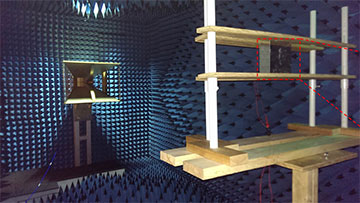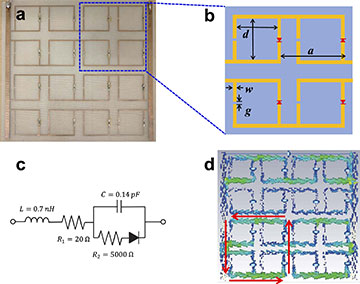Metamaterial-based antenna design. (a) Split-ring resonator array with Schottky diodes embedded in the gaps. (b) The unit cell. (c) Effective circuit model for the Schottky diode. (d) Surface current modes are activated at the resonance frequency. [Image: C. Fowler et al., Opt. Mater. Express 12, 1242 (2022)] [Enlarge image]
There is a growing amount of ambient electromagnetic energy from cell phone networks, Wi-Fi, GPS and Bluetooth signals. This energy could, in theory, be scavenged to power electrical devices. However, previous attempts to harvest radio waves have not yielded enough direct current (DC) to be useful.
Now, physicists from the University of South Florida, USA, have demonstrated a metamaterial-based antenna prototype that can efficiently harvest radio waves from the air and convert them into electricity to wirelessly run low-energy devices like smart home sensors and LEDs (Opt. Mater. Express, doi: 10.1364/OME.449494).
“With the huge explosion of radio-wave-based technologies, there will be a lot of waste electromagnetic emissions that could be collected,” said team lead Jiangeng Zhou in a press release. “This, combined with advancements in metamaterials, has created a ripe environment for new devices and applications that could benefit from collecting this wasted energy and putting it to use.”
A “perfect” radio-wave absorber
For their antenna, Zhou and his team used a metamaterial perfect absorber (MPA)—a fairly new type of metamaterial that offers flawless electromagnetic wave absorption and strong field enhancement or harvesting low-intensity radio waves.
The researchers fabricated their MPA-based antenna on a copper-coated FR4 circuit board using lithography and chemical etching. The MPA consisted of three layers: a 4×4 array of double-gap split-ring resonators (SRRs), a highly reflective layer and a subwavelength-thick dielectric film spacer. The researchers soldered a Schottky diode across one gap in each SRR to create DC voltage by rectifying resonant current excited by incident radio-frequency waves.
Demonstration in an anechoic chamber

Researchers tested a radio-wave harvesting metamaterial-based antenna in an anechoic chamber. Radio waves sent out by a signal generator on the left are received by the metamaterial-based antenna on the right. [Image: J. Zhou and C. Fowler]
For a proof-of-concept demonstration, the researchers placed their 16-cm2 MPA-based antenna 380 cm away from a radio-frequency signal generator in an anechoic chamber that prevented reflections of electromagnetic and sound waves. Next, they aimed radio waves ranging between 0.7 and 2.0 GHz from the signal generator at the MPA-based antenna.
Results from the demonstration show that the MPA-based antenna harvested 100 µW from the radio waves—“a typical threshold for low-power electronic devices,” according to the researchers. In a second demonstration, they were able to power an LED with the energy harvested from an in-use cell phone close to the antenna.
The next steps for the team include scaling down the size of the MPA-based antenna and making a version that can simultaneously collect energy from different radio-wave sources.

